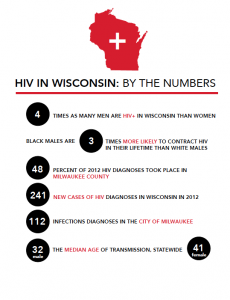Open a map of Wisconsin. Locate Milwaukee and draw a small circle around the downtown urban center. That circle, tiny though heavy, holds 60 percent of Milwaukee’s black population. It is a loop around someone’s mother, someone’s son, someone’s hero. Struggling with disproportionate levels of unemployment, poverty, incarceration and segregation, that tiny circle is a ring around just six zip codes. And yet, that small circle on a large map holds the lives of 70 percent of new HIV infections in the city of Milwaukee.
Researchers at UW-Madison, along with community partners, are working to break the cyclic and devastating health disparities in Milwaukee County, combating homophobia and the transmission of HIV with lessons of love and tolerance.
Black men in Milwaukee County are three times more likely to contract HIV in their lifetime than white men.
Acceptance Journeys, a project led by UW-Madison Assistant Professor Shawnika Hull, and Diverse and Resilient, a Milwaukee-area lesbian, gay, bisexual and transgender (LGBT) health organization, is a mass media campaign aimed to negate the health disparities in Milwaukee County; namely, the disproportionately high transmission rates of HIV among a specific demographic in the black community. They utilize promotional narrative cards, one side detailing the story of a brave journey taken toward inclusivity and unconditional love, the other showing a picture, perhaps an image of two sisters embracing or a mother holding her son’s hand.
“We have been too hesitant in the black community to be allies … our being in denial of our gay brothers and sisters causes pain and unnecessary suffering for people whom we love and about whom we care,” reads the back of one story card, narrating the journey to acceptance – a familiar journey for many families. “For me, that’s just so inconsistent with who we’re supposed to be as black people.”
The program, whose slogans and photographs cover city buses, hang at Amtrak stations and are plastered across billboards, challenges people to reframe the way they think about LGBT individuals. By including narratives that highlight the power of love and acceptance, partners of the project hope to combat the area’s rampant levels of homophobia, ultimately leading to lower levels of HIV in the most segregated city in the country.
HIV is thought of by many as an “’80s disease,” made infamous by tragically high transmission rates in cities like San Francisco and New York. While the larger Wisconsin community now experiences generally low transmission rates of HIV, some groups in Milwaukee County, specifically young, black, gay and bisexual men, experience transmission at a rate unseen anywhere else in the state – mostly due to massive disparities across racial and socio-economic status divides. According to the Wisconsin Department of Public Health, the city of Milwaukee accounted for 48 percent of HIV diagnoses in Wisconsin in 2012, but makes up only 10 percent of the state’s population.
“Disparities are a consequence of disproportionate transmission of HIV, a consequence of the individual decisions we make, the circumstances in which we find ourselves, the social situations in which we’re placed and the disease burden in our community, Hull says. “If we’re going to do something about it, we have to take a multi-pronged approach.”
According to Acceptance Journeys, there are four major components to higher transmission of HIV among particular groups in Milwaukee County – housing instability, the severe stigma surrounding HIV, internalized homophobia and a general code of silence among the community – each combining to create a social environment where men who have sex with men experience a heightened risk of coming into contact with HIV.
By looking to the underlying cause of the problem, Hull believes that all four of these factors can be assessed and dealt with.
“If a young man comes out to his family and he’s put of the house – he needs somewhere to go. He has to find housing, he has to find food. And who’s a better candidate for support than someone whom a person has an intimate relationship with?” Hull says.
She explains that, with the likelihood that this person is older and more established, their disease burden is higher in the community – meaning that he’s more likely to be HIV positive. “So we think that by impacting homophobia, we’ll reduce the likelihood that [the young man] will be put out on the street in the first place. And we think that by improving acceptance in the community, we can mitigate that internalized stigma that people experience … so all of these pathways – we think that homophobia gets at the root of these problems.”
 Jonathon Rowland* is a gay, black man born and raised in the center of Milwaukee. Agreeing with research done by Acceptance Journeys, Rowland sees societal stigma and internalized gender roles as playing integral roles in homophobia.
Jonathon Rowland* is a gay, black man born and raised in the center of Milwaukee. Agreeing with research done by Acceptance Journeys, Rowland sees societal stigma and internalized gender roles as playing integral roles in homophobia.
“I do think that the stigma of being queer in the black community is exceedingly different than in other ethnic communities. The last thing I want to do is point any fingers, but I suspect that popular hip-hop culture has a lot to do with the way that queer people are perceived and treated in the black community,” Rowland says. “There is a loud call for black men to be tough present in the lyrics of many rap songs, and since being gay is considered a weakness, it must be concealed.”
In understanding that there are more factors to transmission than the isolated choices of an individual, we shift the focus away from the victim and use it to readjust the lens through which we view society and culture.
“If we can get somebody to use condoms, that’s great. That’s one pathway,” Hull says. “But if we can get at homophobia, we can get at a bunch of them. That’s the plan.”
The campaign, based on an initial community readiness assessment, intensifies each year. The assessment, designed to gauge current community opinions and knowledge about HIV/AIDS, informed the team on how best to proceed.
“We try to deal with the things on people’s minds when they think about gay men, but we try to do it in a way that keeps them receptive to our message,” Hull says. “We think that all of these activities together should have some consequence for the way people talk, the things people believe and the way that they act. So it’s not just that we expect the story cards to work, or for the billboards to work, but all of them together should slowly begin to make changes in the community.”
Gay and bisexual men comprise four to eight percent of the population of Milwaukee County, and yet represent 63 percent of HIV positive individuals.
A major outcome of combating homophobia is increasing the likelihood that men will get tested for HIV. People who test positive are more likely to seek treatment. Even if there is no other behavior change, likelihood of transmission will reduce with treatment, as the viral load, or the amount of virus in the body, will decrease.
Many other community organizations are working to encourage people to get tested. Acceptance Journeys’ partner, Diverse and Resilient, receives federal grants that the organization has used to test over 600 men who have sex with men for HIV in the past two years.
Katie Hamm, the prevention program manager at Diverse and Resilient, says that in looking at HIV rates in Milwaukee, researchers needed to determine whether there was a higher rate of disease, or if resources were merely doing a better job of testing the highest risk population. “The Center for Disease Control determined that we [do] have a higher instance of HIV, which is very much on par with urban areas across the country,” Hamm says.
Diverse and Resilient also works on other health interventions, including a Milwaukee-wide condom distribution program, testing, programming to reduce use of tobacco and alcohol abuse among youth and addressing the need for inclusive, comprehensive sexual education in public school systems.
“[We’re] really wrapping our arms around HIV prevention,” Hamm says. “At the individual level, at the community level and at the state level.”
From 2010-2012, 83 percent of HIV diagnoses among young men who have sex with men in the city of Milwaukee were black, 11 percent were Hispanic, three percent were white and three percent were comprised of other racial groups.
But segregation, both racially and socio-economically, remains one of the largest factors in HIV rates in Milwaukee. Acceptance Journeys says that sometimes, pushback from the community is difficult to deal with. The demographics with the largest health disparities are also among a population with disproportionate rates of violence, imprisonment, unemployment and poverty. It may be difficult for some people to respond to a campaign promoting acceptance when they themselves have been shunned or forgotten by many community and state institutions.
“It’s hard to say, ‘What you should be thinking about is stigma,’ when what they’re really thinking about is, ‘My landlord is on my back about rent and I just got let go from my job,’” Hull says.
Participants in focus groups often ask why anyone would come out as gay. If they do, the consequences – from stigma to risk of losing housing to homophobia – are abundant. Society makes it difficult for them to come out. We punish them for being honest about who they are.
Whose life could you change with love?
A final card shows a woman and her daughter embracing, and, on the back, tells the story of a mother’s love.
“When Joyce first told me she was gay, back in 1982, she was crying. I think maybe she was afraid that I would change towards her if I knew. But that’s my child. I birthed her into this world,” writes Autry Fay. “We are all human. I think parents should love their children. I’m not ashamed of my daughter … she came from me. I always say, ‘God bless everybody in the whole world, no matter what.’ We need to love each other.”
*Name changed to protect privacy




